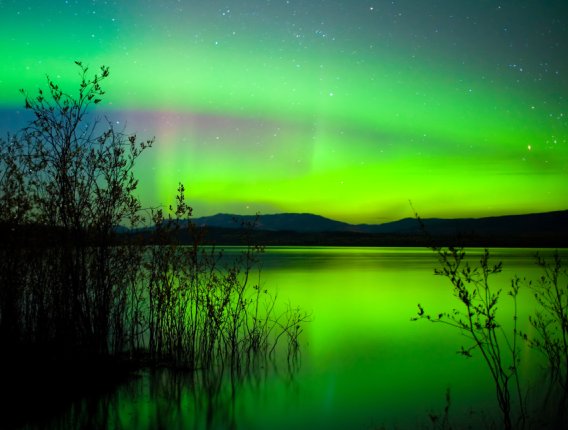
Solar Flare may cause Northern Lights Show

When will the shock waves hit?
(Sorry, this event has already passed)
Details and Northern Lights Viewing Tips
By J. THOMAS -- Soft Serve News, Posted: January 20, 2012
A significant solar flare has occurred on the Sun which may produce impressive Aurora Borealis displays in the days ahead.
The M-Class solar flare (magnitude M3) occurred on Thursday, January 19, 2012. The event caused a Coronal Mass Ejection (CME). The CME is a fast moving cloud of charged particles which is now speeding towards Earth.
NASA's Goddard Space Flight Center estimates that the leading edge of the CME shock wave will hit Earth on approximately Sunday, January 22, 2012. Goddard estimates the duration of the magnetic disturbance will be 9 hours. It is this disturbance of the Earth's magnetic field that causes the Aurora. The arrival time and duration are rough estimates, so Aurora Borealis watchers should be looking for possibly significant displays on the evening of Sunday, January 22, 2012. Real-time Aurora Borealis forecasts can be obtained at the Aurora Borealis Forecast page at Soft Serve News.
Strong CMEs can sometimes cause trouble for satellites and create problems with electrical grids by inducing currents as the CME cloud interacts with the magnetic field that surrounds the earth.
Powerful CMEs however can also produce large Aurora Borealis displays that can be visible much further south than is typical. The Aurora Borealis, also known as the Northern Lights, can range from a faint green glow on the northern horizon to a multicolored, full-sky display which can be one of the most beautiful and awe-inspiring scenes in nature.

WILL YOU BE ABLE TO SEE THE AURORA?
To determine if you can see the Northern Lights use the following three steps:
Step 1 -- Know your Location's "KP number."
The KP number is the Geomagnetic Activity Level. The stronger the Aurora, the larger the KP number and the further south it can be seen. Find the KP number for your location on the one of the maps below. On the night you wish to view, periodically check the real-time Aurora Borealis Forecast. This will give you the KP number prediction for the Aurora for the next hour or so. If that number is greater or equal to the number on the map for your location, you're in luck. Even if the predicted number is one or two points too low, it still might be worth a look.


Step 2 -- Check the Weather.
Auroras happen in the upper atmosphere, so if there are clouds blocking your view of the stars, you won't be able to see the Aurora.
Step 3 -- Shop for a Dark Spot.
Get away from those city lights. Darkness is best for viewing the Aurora. The fewer competing lights sources, the better. But it is also very important to remember the widest part of the Aurora is when the sun is on the opposite side of the earth. So you want late, nighttime dark.
EXPECTATIONS
Experienced Northern Lights hunters are familiar with disappointment. Predictions of when the CME cloud hits the earth are not always accurate. Sometimes CME events produce much smaller displays than expected, or even none at all. Also, it is possible the main Auroral event happens during the day and consequently can only be enjoyed by people on the other side of the world where it's dark.
Even with these uncertainties, seeing the grandeur of a powerful Aurora Borealis display may be a once in a lifetime event, so for some it's worth the gamble to try.